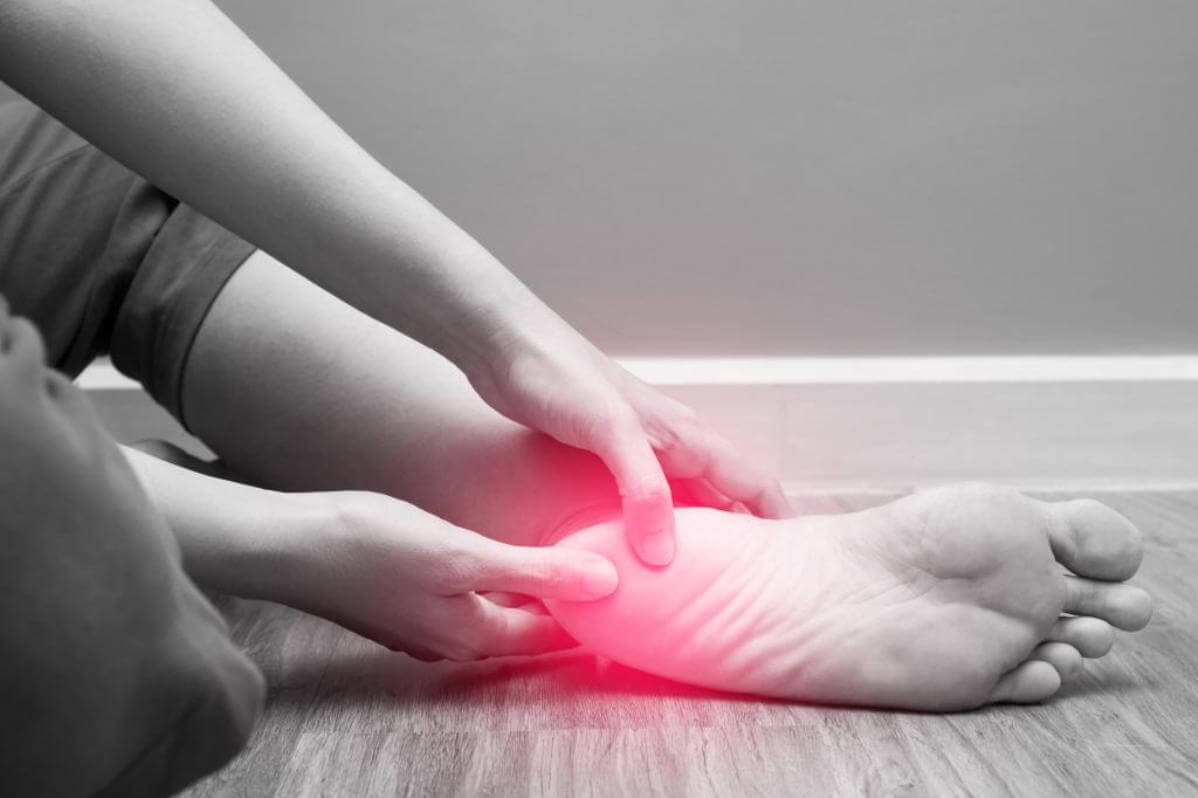Plantar fasciitis is the most common cause of heel pain in adults. It most often affects older adults, particularly men over forty, but can affect young adults, especially if they are very active and involved in athletic activities.
The plantar fascia is the long ligament running down the middle of the foot.
WHAT IS PLANTAR FASCIITIS?
The plantar fascia is a ligament in the bottom of the foot that runs from the base of the heel to the toes. ‘-itis’ in medical jargon means ‘inflammation.’ So plantar fasciitis is inflammation of the plantar fascia. Ligaments are like rubber bands that hold bones together. They stretch and bend as people walk, but if they are over stretched or over used they can be damaged. Early damage in the ligaments causes swelling, as the body rushes blood and nutrients to the damage, trying to heal it.
With proper care and rest, the body is able to heal the damage to the plantar fascia on its own. However if the body isn’t given time to heal, the damage can worsen and more problems can develop.
WHAT ARE THE SYMPTOMS OF PLANTAR FASCIITIS?
The key symptom of plantar fasciitis is heel pain, but there are several problems that can cause pain in the heel. The best way to tell plantar fasciitis from other forms of foot and heel pain is to pay attention to when the pain occurs. In general, plantar fasciitis causes pain either when the ligament is suddenly stretched after being allowed to tighten, or when it is over worked.
Sudden stretching of a tightened plantar fascia can occur:
- Taking the first steps after waking up.
- Standing up after sitting for a long period of time.
The fascia can become over worked after:
- Walking or running uphill or over uneven ground.
- Standing for a long period of time.
- Climbing stairs.
- A long day that involved a lot of walking.
Anyone having pain at these times may have plantar fasciitis. Pain during the middle of the night is not caused by plantar fasciitis and is an indication that there is another cause for the pain.
The pain from plantar fasciitis is typically a stabbing or burning pain that goes away quickly when resting.
CAUSES OF PLANTAR FASCIITIS
The damage to the ligament that causes plantar fasciitis can be caused in several ways:
- Athletes and soldiers often develop plantar fasciitis as a repetitive motion injury after walking and running for excessive periods of time for days or weeks on end.
- Poorly fitting shoes can put excessive strain on the fascia and eventually cause damage, as the body fails to compensate for the strain.
- Many people can develop plantar fasciitis due to a structural problem in their foot. A tendency to pronation (the foot rolling inward when you walk), a high arch or no arch can all pull the plantar fascia in unintended ways, leading to long term damage and pain.
- Very tight Achilles tendons and calf muscles can pull on the plantar fascia, making it over tight and prone to injury.
Over all the most common cause of plantar fasciitis is poorly fitting shoes. Early stages of plantar fasciitis can often be corrected by getting good fitting shoes and heel supports to take the strain off of the ligament.
PREVENTING PLANTAR FASCIITIS
There are several things that can be done to prevent plantar fasciitis. The most important thing, as already mentioned, is to make sure all shoes that are worn frequently fit well and give good support for the heel and arch. Anyone standing for long periods of time because of a job or hobby should invest in a thick rubber mat to stand on, which can reduce stress on the feet.
Regular stretches for the Achilles tendon can be especially helpful for athlete, though non-athletes can benefit as well. Recent studies have caused major changes in recommended stretching routines, so speak with a physical therapist or personal trainer about the best stretches.
Runners should alternate running with other sports that do not put stress on the feet, allowing the body time to heal between long runs.
Anyone with structural problems in their feet should put on supportive shoes as soon as they wake up, to prevent additional strain from going barefoot.
TREATING PLANTAR FASCIITIS
For the most part, plantar fasciitis is treated with lifestyle changes and easy exercises that can be done at home. In severe cases, a doctor may recommend seeing a physical therapist to identify necessary changes in routine and exercise. Plantar fasciitis does not heal quickly, and on average it takes around 9 months after treatment for the pain to go away. Surgery is sometimes used for plantar fasciitis that doesn’t respond to other treatment, but only if the pain continues for over a year.
The pain from plantar fasciitis can be treated with over the counter anti-inflammatory medications such as ibuprofen, naproxen or aspirin. Ice is another good treatment for plantar fasciitis pain, because it can reduce inflammation. Do not use heat for the pain, because heat can make the inflammation worse.
When the pain hits, it is important to immediately take strain off the feet and rest if at all possible.
One of the best ways to treat plantar fasciitis is to get new shoes that fit well, possibly with heel support inserts to take strain off of the fascia while it heals. Athletes should get new athletic shoes after about 500 miles of wear, or wearing those three months, whichever comes first.
If pain is frequent in the morning, there are foot braces called night splints that hold the foot in a position that prevents the fascia from tightening overnight.
It is important make treatments for plantar fasciitis a part of the daily routine, and to be patient. Regular stretching, good shoes and rest are enough to heal most cases of plantar fasciitis without other interventions. However ligaments are slow to heal, especially those in the feet that are under near-constant strain. With regular treatments and care a person suffering from plantar fasciitis should see improvement within six weeks, though it will much longer for the pain to go away entirely. If the pain hasn’t improved in two months, it is important to talk with a doctor about other treatment options or other possible causes.
PLANTAR FASCIITIS AND HEEL SPURS
For a long time, doctors believed that heel spurs, small bone growths in the bottom of the heel, caused the pain of plantar fasciitis. Recent studies have shown that heel spurs are common in people who have never had any heel pain, and that removing heel spurs does not necessarily cause any improvement. Some doctors now believe that heel spurs are caused by plantar fasciitis, rather than the other way around. If an X-ray shows a heel spur, it is not a cause for concern and will have no impact on developing or treating plantar fasciitis.
OTHER CAUSES OF HEEL PAIN
There are several things that can cause heel pain similar to plantar fasciitis. If treatment does not help the pain, or if symptoms are different from those of plantar fasciitis, talk with a doctor about whether one of these problems may be the cause:
- Stress Fracture of the Heel – Stress fractures are caused by intense physical activity, especially after insufficient stretching.
- Arthritis – In particular, arthritis in the heel and ankle.
- Circulation problems – If pain is common after sitting and not moving, and never occurs after physical activity, than circulation problems, which are worse when resting, may be contributing.
- Nerve Entrapment – When a nerve is trapped or pinched between bones or ligaments, it is rather like banging your funny bone repeatedly.
- Bursitis or Tendinitis – These are other inflammation injuries caused by overuse of different parts of the foot.
- Wearing away of the heel pad – As the cushion under the heel gets worn away, the bone is more exposed and becomes more sensitive.
- Sciatica – Usually caused by a herniated disc, sciatica can cause pain at any point in the lower body.
- Ruptured Plantar Fascia – If plantar fasciitis is not treated, the damage can get worse until the ligament rips away from the heel entirely. When this happens regular treatment can’t help and surgery is needed to reattach the ligament.
With care and attention to foot wear, it is often possible to prevent plantar fasciitis from developing. Stretching in the morning and before activity, making sure the heel and arch are well supported, and moving frequently during the day, so the fascia does not either over stretch from standing too long or tighten from sitting too long can go a long way towards protecting against this problem. Sometimes, even with the best care, plantar fasciitis develops anyway. If it does, it is important to take steps immediately to address the pain and help the body heal, before the damage gets worse, possibly developing into a ruptured ligament. If pain does not start getting better with basic treatment, speak with a doctor about what other treatment options are available, and whether or not something else may be causing the pain. Plantar fasciitis is a painful and sometimes debilitating condition, but with care and attention, it can be treated.









